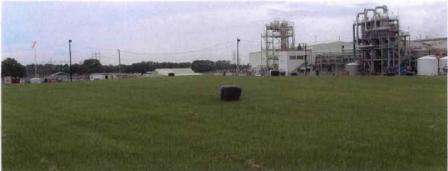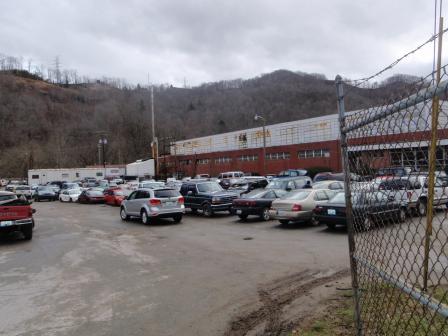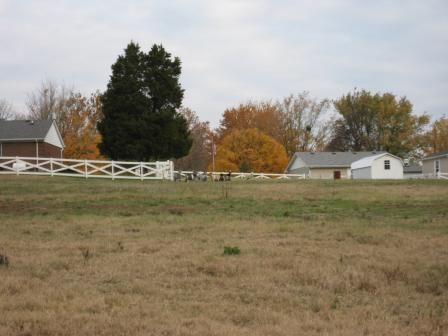Superfund Sites in Reuse in Kentucky
If you are having trouble viewing the map in your browser, click the 'View larger map' link below
B.F. Goodrich
 B.F. GoodrichThe B.F. Goodrich (BFG) Superfund site is located 1 mile northeast of Calvert City, Kentucky. The site consists of two neighboring landfills: the BFG Landfill and the Airco Landfill. Opened in 1953, the BFG Landfill incinerated waste from nearby chemical plants. Opened in 1956, the Airco Landfill accepted waste materials from the Airco Plant in Calvert City. After closing both landfills by 1981, Kentucky Department of Environmental Protection (KDEP) inspections found that liquids leaking from the landfills had contaminated soil and groundwater. EPA added the site to the Superfund program’s National Priorities List (NPL) in 1983. Cleanup activities conducted by EPA, BFG and AIRCO included removing and treating groundwater, improving landfill covers and putting land use restrictions in place. Cleanup also included removal, treatment and capping of contaminated soil in a former burn pit area. In the 1990s, the Westlake Chemical Company purchased most of the property and plant facilities. The company currently operates a large plastics production facility at the site. In 2000 and 2001, Cymetech LLC and Lubrizol Corporation, purchased some of the site property and currently operate facilities at the BF Goodrich Site. PolyOne also owns and operates facilities at the BF Goodrich Site.
B.F. GoodrichThe B.F. Goodrich (BFG) Superfund site is located 1 mile northeast of Calvert City, Kentucky. The site consists of two neighboring landfills: the BFG Landfill and the Airco Landfill. Opened in 1953, the BFG Landfill incinerated waste from nearby chemical plants. Opened in 1956, the Airco Landfill accepted waste materials from the Airco Plant in Calvert City. After closing both landfills by 1981, Kentucky Department of Environmental Protection (KDEP) inspections found that liquids leaking from the landfills had contaminated soil and groundwater. EPA added the site to the Superfund program’s National Priorities List (NPL) in 1983. Cleanup activities conducted by EPA, BFG and AIRCO included removing and treating groundwater, improving landfill covers and putting land use restrictions in place. Cleanup also included removal, treatment and capping of contaminated soil in a former burn pit area. In the 1990s, the Westlake Chemical Company purchased most of the property and plant facilities. The company currently operates a large plastics production facility at the site. In 2000 and 2001, Cymetech LLC and Lubrizol Corporation, purchased some of the site property and currently operate facilities at the BF Goodrich Site. PolyOne also owns and operates facilities at the BF Goodrich Site.
For more information:
National Electric Coil Co./Cooper Industries
 National Electric Coil Co./Cooper IndustriesThe 3.5-acre National Electric Coil Co./Cooper Industries Superfund site is located in Dayhoit, Kentucky. The National Electric Coil Company operated an industrial equipment rebuilding and remanufacturing facility on site from 1951 until 1985. Throughout several changes in ownership, site operations continued. Operations included electrical motor repair work and rebuilding of hydraulic systems for the coal industry. Improper disposal practices at the site resulted in contamination of groundwater and soil. In 1989, a routine community well sampling event detected contaminated drinking water. The parties responsible for the contamination connected affected residences to the public water supply system. In 1992, EPA added the site to the Superfund program’s National Priorities List (NPL). Cleanup activities included removing contaminated soil and treating contaminated groundwater. Since 2010, the property has been in use as an automobile salvage yard under new ownership.
National Electric Coil Co./Cooper IndustriesThe 3.5-acre National Electric Coil Co./Cooper Industries Superfund site is located in Dayhoit, Kentucky. The National Electric Coil Company operated an industrial equipment rebuilding and remanufacturing facility on site from 1951 until 1985. Throughout several changes in ownership, site operations continued. Operations included electrical motor repair work and rebuilding of hydraulic systems for the coal industry. Improper disposal practices at the site resulted in contamination of groundwater and soil. In 1989, a routine community well sampling event detected contaminated drinking water. The parties responsible for the contamination connected affected residences to the public water supply system. In 1992, EPA added the site to the Superfund program’s National Priorities List (NPL). Cleanup activities included removing contaminated soil and treating contaminated groundwater. Since 2010, the property has been in use as an automobile salvage yard under new ownership.
For more information:
National Southwire Aluminum Co.
The 475-acre National Southwire Aluminum Co. Superfund site is located northwest of Hawesville, Kentucky. Part of a larger 1,100-acre property, the site sits on the west bank of the Ohio River. Southwire began operating an aluminum reduction facility at the site in 1969. Facility operations and waste handling practices resulted in groundwater and soil contamination. In 1985, EPA found contamination in drinking water wells at and near the site. In 1994, EPA added the site to the Superfund program’s National Priorities List (NPL). Cleanup activities included treatment of contaminated groundwater, removal and off-site disposal of some contaminated soil, and capping of remaining contaminated soil. Cleanup also included placing restrictions on land use and monitoring of the site. In 2001, Southwire transferred ownership of the property to Century Aluminum of Kentucky, LLC, which currently operates the on-site aluminum reduction facility.
For more information:
Tri-City Disposal Co.
 Tri-City Disposal Co.The Tri-City Disposal Co. Superfund site is located in Shepherdsville, Kentucky. From 1964 to 1967, the Tri-City Disposal Company operated a 57-acre landfill on the 349-acre property. Various Louisville industries disposed of highly volatile liquid wastes, lumber scraps and fiberglass insulation materials at the site. Activities at the site contaminated two springs with volatile organic compounds, a tributary of the Brushy Fork Creek with heavy metals, and ground water and soils with organic compounds. EPA added the site to the National Priorities List (NPL) in 1989. Cleanup activities included putting ground water use controls in place, treating contaminated water, and long-term monitoring for ground water, surface water, sediment and ecology. A family currently owns most of the site and maintains two residences as well as a recently constructed metal barn on the property. Neighbors use the remaining acreage of the site for residential and agricultural purposes, including animal grazing.The 16.5-acre Hercules 009 Landfill Superfund site is located in Brunswick, Georgia. From 1948 through 1980, Hercules, Inc. used 7 acres at the northern end of the site, known as the 009 Landfill, to dispose of waste. In March 1980, the Georgia Environmental Protection Division (EPD) collected samples that revealed contamination on site. As a result, EPD canceled Hercules, Inc.’s permit to operate the landfill. In 1982, site operations ceased. EPA added the site to the Superfund program’s National Priorities List (NPL) in 1984. In 1991 and 1993, EPA issued cleanup plans that included stabilizing on-site soil and sludge; installing a cap over the landfill; monitoring groundwater, surface water and sediment in the on-site pond and the drainage ditch next to the site; and long-term landfill cap maintenance. Taking advantage of the location of the landfill cap, a car dealership directly north of the site worked with the potentially responsible party to put the site back into reuse without harming site cleanup efforts. The car dealership fenced and paved the top of the capped landfill to create a parking lot to display its cars. This use has helped to further preserve the integrity of the capped landfill beneath. Over the past few years, Hercules began working with the Wildlife Habitat Council to obtain a Conservation Certification for the southern on-site pond area. The company has installed wildlife cameras, basking logs and cover boards to attract insects and reptiles. Wildlife cameras have documented raccoons, foxes, squirrels and large birds at the site.
Tri-City Disposal Co.The Tri-City Disposal Co. Superfund site is located in Shepherdsville, Kentucky. From 1964 to 1967, the Tri-City Disposal Company operated a 57-acre landfill on the 349-acre property. Various Louisville industries disposed of highly volatile liquid wastes, lumber scraps and fiberglass insulation materials at the site. Activities at the site contaminated two springs with volatile organic compounds, a tributary of the Brushy Fork Creek with heavy metals, and ground water and soils with organic compounds. EPA added the site to the National Priorities List (NPL) in 1989. Cleanup activities included putting ground water use controls in place, treating contaminated water, and long-term monitoring for ground water, surface water, sediment and ecology. A family currently owns most of the site and maintains two residences as well as a recently constructed metal barn on the property. Neighbors use the remaining acreage of the site for residential and agricultural purposes, including animal grazing.The 16.5-acre Hercules 009 Landfill Superfund site is located in Brunswick, Georgia. From 1948 through 1980, Hercules, Inc. used 7 acres at the northern end of the site, known as the 009 Landfill, to dispose of waste. In March 1980, the Georgia Environmental Protection Division (EPD) collected samples that revealed contamination on site. As a result, EPD canceled Hercules, Inc.’s permit to operate the landfill. In 1982, site operations ceased. EPA added the site to the Superfund program’s National Priorities List (NPL) in 1984. In 1991 and 1993, EPA issued cleanup plans that included stabilizing on-site soil and sludge; installing a cap over the landfill; monitoring groundwater, surface water and sediment in the on-site pond and the drainage ditch next to the site; and long-term landfill cap maintenance. Taking advantage of the location of the landfill cap, a car dealership directly north of the site worked with the potentially responsible party to put the site back into reuse without harming site cleanup efforts. The car dealership fenced and paved the top of the capped landfill to create a parking lot to display its cars. This use has helped to further preserve the integrity of the capped landfill beneath. Over the past few years, Hercules began working with the Wildlife Habitat Council to obtain a Conservation Certification for the southern on-site pond area. The company has installed wildlife cameras, basking logs and cover boards to attract insects and reptiles. Wildlife cameras have documented raccoons, foxes, squirrels and large birds at the site.
For more information:
